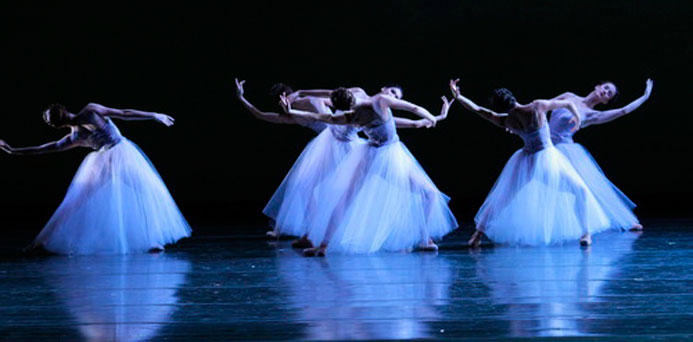 Dance can be modern, classical or theater with movement. The Joffrey Ballet embraces them all in its fall program.
Dance can be modern, classical or theater with movement. The Joffrey Ballet embraces them all in its fall program.
Three ballets are being presented under the title “Human Landscapes,” and each one confronts humanity in its own way.
Most powerful, of course, is Joffrey’s revival of “The Green Table,” a German Expressionist ballet, choreographed by Kurt Jooss in 1932. Definitely theater with movement, it illustrates the statement that old men send young men to war. It is less a dance than a wordless drama in which the deceits of diplomacy, the zeal of patriotism, the agonies of the battlefield and the anxieties on the home front are vividly portrayed in stylized movement.
When the ten so-called Gentlemen in Black at the green negotiating table fire pistols in the air, war is declared and Death appears. He is portrayed by Fabrice Calmels, surely one of Joffrey’s tallest and most powerful men. Death eventually dances with every person and is the final victor in any conflict.
In the case of the old mother of a fallen soldier, danced by April Daly, she finally embraces the monstrous figure, as the death of her son has killed her.
Two pianists, Mungunchimeg Buriad and James Lewis, play the powerful score by F. A. Cohen. The composer toys with our emotions, writing jaunty tango music for the diplomatic scenes, dark, sinister drum beats as strong young men leap into battle and funereal music as Death bears them all away.
Death even strikes the worldly wise War Profiteer, danced like a sinister snake by the magnificently flexible Temur Suluashvilli.
Jooss specified that “The Green Table” be the final work on any program. But least it seem too heavy, the first two numbers, “Forgotten Land,” choreographed by Jiri Kylian of Czechoslovakia, and “Pretty Ballet,” choreographed by Canadian James Kudelk are not nearly as grim.
Even though “Forgotten Land” is danced to Benjamin Britten’s “Sinfonia da Requiem,” it is about relationships and the blessings and burdens they bring into our lives. First women in ballet slippers stand, backs to the audience, gazing out at the vast sea, Kylian’s homage to Edvard Munch. One by one partners arrive and cymbals crash as the couples embrace.
Of special note are April Daly and Joffrey newcomer Yoshihisa Arai, who have some of the most inventive moves in the piece. Clad in red, they appear so delighted with each other, that their joy just leaps over the footlights.
Eventually, however, the couples part, men first, then women. Lean, reedy music surrounds the final pair who endure until almost the end. Finally, however, the women are again alone. Standouts here are the splendid Victoria Jaiani, Christine Rocas and Alexis Polito.
“Pretty Ballet” is just that. The four-movement piece is danced to an appealing score by Bohuslaf Martinu with glorious costumes by Denis Lavoie. It begins with women en pointe appearing to float onto a stage covered by fog. They move in a fluid Romantic style, while the men’s movement are more angular, less graceful. Is this “women are from Venue, men are from Mars?”
Again Jaiani does a star turn, partnered by Miguel Angel Bianco, who briefly holds her aloft with his right arm!
Both “Forgotten Land” and “Pretty Ballet” are accompanied by the Chicago Philharmonic, now the official orchestra of the Joffrey Ballet. Fortunate indeed is the company to have such a superior group of professionals in the pit to accompany their finely honed dancers.
“Human Landscapes” will be performed through Oct. 28 at the Auditorium Theatre of Roosevelt University, 50 East Congress Parkway, Chicago. For tickets visit the Auditorium box office or the lobby of Joffrey Tower, 10 E. Randolph, or contact Ticketmaster at 800-982-2782. For more information, visit joffrey.org.

